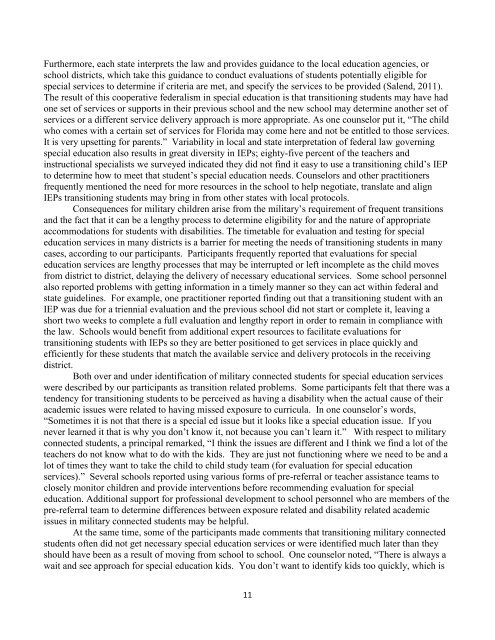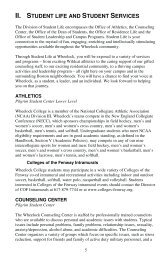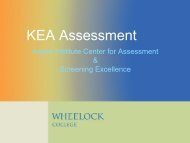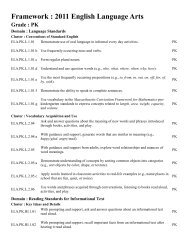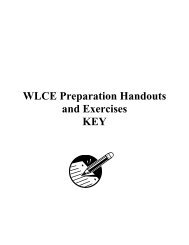Download the study (pdf)
Download the study (pdf)
Download the study (pdf)
Create successful ePaper yourself
Turn your PDF publications into a flip-book with our unique Google optimized e-Paper software.
Fur<strong>the</strong>rmore, each state interprets <strong>the</strong> law and provides guidance to <strong>the</strong> local education agencies, orschool districts, which take this guidance to conduct evaluations of students potentially eligible forspecial services to determine if criteria are met, and specify <strong>the</strong> services to be provided (Salend, 2011).The result of this cooperative federalism in special education is that transitioning students may have hadone set of services or supports in <strong>the</strong>ir previous school and <strong>the</strong> new school may determine ano<strong>the</strong>r set ofservices or a different service delivery approach is more appropriate. As one counselor put it, “The childwho comes with a certain set of services for Florida may come here and not be entitled to those services.It is very upsetting for parents.” Variability in local and state interpretation of federal law governingspecial education also results in great diversity in IEPs; eighty-five percent of <strong>the</strong> teachers andinstructional specialists we surveyed indicated <strong>the</strong>y did not find it easy to use a transitioning child’s IEPto determine how to meet that student’s special education needs. Counselors and o<strong>the</strong>r practitionersfrequently mentioned <strong>the</strong> need for more resources in <strong>the</strong> school to help negotiate, translate and alignIEPs transitioning students may bring in from o<strong>the</strong>r states with local protocols.Consequences for military children arise from <strong>the</strong> military’s requirement of frequent transitionsand <strong>the</strong> fact that it can be a lengthy process to determine eligibility for and <strong>the</strong> nature of appropriateaccommodations for students with disabilities. The timetable for evaluation and testing for specialeducation services in many districts is a barrier for meeting <strong>the</strong> needs of transitioning students in manycases, according to our participants. Participants frequently reported that evaluations for specialeducation services are lengthy processes that may be interrupted or left incomplete as <strong>the</strong> child movesfrom district to district, delaying <strong>the</strong> delivery of necessary educational services. Some school personnelalso reported problems with getting information in a timely manner so <strong>the</strong>y can act within federal andstate guidelines. For example, one practitioner reported finding out that a transitioning student with anIEP was due for a triennial evaluation and <strong>the</strong> previous school did not start or complete it, leaving ashort two weeks to complete a full evaluation and lengthy report in order to remain in compliance with<strong>the</strong> law. Schools would benefit from additional expert resources to facilitate evaluations fortransitioning students with IEPs so <strong>the</strong>y are better positioned to get services in place quickly andefficiently for <strong>the</strong>se students that match <strong>the</strong> available service and delivery protocols in <strong>the</strong> receivingdistrict.Both over and under identification of military connected students for special education serviceswere described by our participants as transition related problems. Some participants felt that <strong>the</strong>re was atendency for transitioning students to be perceived as having a disability when <strong>the</strong> actual cause of <strong>the</strong>iracademic issues were related to having missed exposure to curricula. In one counselor’s words,“Sometimes it is not that <strong>the</strong>re is a special ed issue but it looks like a special education issue. If younever learned it that is why you don’t know it, not because you can’t learn it.” With respect to militaryconnected students, a principal remarked, “I think <strong>the</strong> issues are different and I think we find a lot of <strong>the</strong>teachers do not know what to do with <strong>the</strong> kids. They are just not functioning where we need to be and alot of times <strong>the</strong>y want to take <strong>the</strong> child to child <strong>study</strong> team (for evaluation for special educationservices).” Several schools reported using various forms of pre-referral or teacher assistance teams toclosely monitor children and provide interventions before recommending evaluation for specialeducation. Additional support for professional development to school personnel who are members of <strong>the</strong>pre-referral team to determine differences between exposure related and disability related academicissues in military connected students may be helpful.At <strong>the</strong> same time, some of <strong>the</strong> participants made comments that transitioning military connectedstudents often did not get necessary special education services or were identified much later than <strong>the</strong>yshould have been as a result of moving from school to school. One counselor noted, “There is always await and see approach for special education kids. You don’t want to identify kids too quickly, which is11


